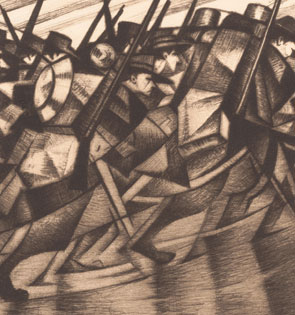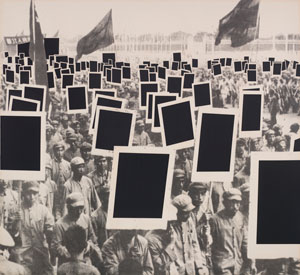The Anger of the Guns
John Haberin New York City
World War I and Art
An Incomplete History of Protest
"What passing-bells for these who die as cattle? / Only the monstrous anger of the guns."
When Wilfred Owens wrote "Anthem for Doomed Youth," he was speaking for a generation. So did other British War poets, such as Siegfried Sassoon and Rupert Brooke—and so did writers like Ernest Hemingway in mapping alienation, exile, and recovery.  Where, though, were the passing-bells in art? With "World War I and the Visual Arts," the Met breaks the silence. Its works on paper follow more artists to the front and back than anyone might have expected. More than a few, too, asked to be there.
Where, though, were the passing-bells in art? With "World War I and the Visual Arts," the Met breaks the silence. Its works on paper follow more artists to the front and back than anyone might have expected. More than a few, too, asked to be there.
Maybe you know Fernand Léger and Filippo Tommaso Marinetti as heirs to Cubism, the first in France and the second with Futurism, the movement in Italy. Maybe you know much of the rest as a roster of German Expressionism. If not, no matter. Even if you do not know their work by heart, you can feel the pain. The war did not always shape their styles, whatever the Met may say. They could bring their experience to their art all the same.
The Met is not the only museum to connect art and war. The Whitney, too, uses its collection to make the link inescapable, starting with the turmoil of the 1960s and not concluding even now. Here, though, the emphasis is on what art brings to politics, most especially domestic politics. It calls its display of political art "An Incomplete History of Protest." Does that mean something is missing? You had better hope so, but what is there will still provoke you.
On opening day, America was reeling from Neo-Nazis rallies, violent confrontations over Confederate monuments, and Donald J. Trump's shameful excuses. And the show ends with text directly on the wall—starting with No to racism and No to fascism, but with No hope without rage as well. As long ago as 1980, Howardena Pindell peeled away a white face to reveal black flesh, in a video loop that will never end. They have taken on a relevance that the artists neither anticipated nor desired. They ask implicitly what comes next. They ask, too, whether the urgency of protests can fully translate into art.
Speaking from experience
As poets, Wilfred Owens and Siegfried Sassoon were speaking from experience, and so were artists. Otto Dix operated a machine gun, and Fernand Léger, a conscript who sketched furiously at the front, nearly died from chemical weapons. George Grosz and Ernst Ludwig Kirchner, both volunteers, suffered mental breakdowns, including hallucinations and nightmares. Erich Heckel, Ernst Barlach, and Max Beckmann served as medical orderlies, although Egon Schiele died in 1918 without seeing combat. By the war's end, Marinetti, too, lay among the wounded. Käthe Kollwitz, whose woodcuts show mothers and children huddled together, lost a son.
Others, like Edward Steichen, the American photographer, and John Singer Sargent, the American painter then living in London, followed the armies to document the war. The British armies alone employed sixteen photographers. Still others saw in combat a message to or metaphor for art. Wyndham Lewis and Vorticism, a British movement in the wake of Cubism, called their publication Blast, while Marinetti was still more insistent in his Futurist manifesto: "we intend to glorify war – the only hygiene of the world." Be careful what you wish for.
Somehow, though, the silence persists. When you think of art in those years, you may think first of Dada, reveling in the neutrality of Switzerland—or of František Kupka, Francis Picabia, and Wassily Kandinsky turning their back on war to invent abstraction. You may think of Marsden Hartley, who had to return to America with the outbreak of war. He also had to leave behind his crush on a German officer. The dizzying pace of early Soviet art came about only because the Bolsheviks took their country out of war. Among those still present, Sargent in watercolor finds in a vault for military equipment much the same breathtakingly clear sunlight he had as in Venice.
That still leaves much of a continent in ruins. The Met sees an arc from initial enthusiasm at war to horror and revulsion, but it was difficult to separate them even from the start. Before her support for the Russian Revolution, Natalia Goncharova moved easily between "Christian hosts" and "doomed cities." Gino Severini exhibited his collage of near abstract human outlines and news clippings in the first Futurist exhibition. When others depict massed soldiers, they, too, borrow the hurtling rhythms of Futurism—but also the slower rhythms of toil and entrapment. Christopher Richard Wynne Nevinson served as official artist for the British armies, but his Returning to the Trenches has little to celebrate.
Ironies dogged them or guided them all along. A poster called for American recruits to "destroy this mad brute"—and yet German propaganda used much the same image of a savage ape to boast of its power. Pierre Bonnard in France adopted the absurdist comedy of Alfred Jarry and Ubu Roi to a world at war, while George Bellows, the American, skewered German atrocities as a "bacchanale." As the supreme irony, the show reaches its acme in peacetime, because individuals and societies create a living memory only in retrospect. Among the few loans from outside the Met, Dix's The War commemorated the tenth anniversary of the start of hostilities, with a hallucinatory world between documentation, caricature, and Surrealism. Its fifty-one sheets also present a compendium of brutality in their techniques, from coarse lines to washes of deadly shadow.
The show has its rediscoveries in Nevinson and Margaret Hall, who photographed barbed wire above a trench and a solitary woman in No Man's Land. It has little to say, though, of the war as history or why others preferred silence. It includes postcards, trading cards, maps, and posters in support of the war effort, as well as a gas mask and military helmets—but only as, for all intents and purposes, works of art. Even when it comes to Futurism, it never so much as mentions that Umberto Boccioni died in the war. Still, the silence alone says something worth hearing. Ezra Pound wrote that "literature is news that stays new," but modern art may be instead strangeness that stays strange.
A grade of incomplete
The Whitney asks about not just the impact of art, but also what counts as political art in the first place. An author of that concluding wall print, Paul Chan, became known for only the most elusive of political references—a falling man after 9/11. Julie Mehretu approaches abstraction with her scrawled response to current events from police killings to California wildfires, and so does Mark Bradford covering excerpts from the Constitution in bold red. So, too, does a flag by Theaster Gates made of fire hoses, the kind so often turned against protestors. A square by Ad Reinhardt from 1963 could be the very paradigm of formalism for all its blackness. They suggest that art responds to those who would impose silence, and it does so by demanding to see past gestures of effacement.
 Any history drawn from a museum's collection will fall short of complete. Those looking for more of the African American experience would do well to look to "The Body Politic" at the Met Breuer, "Uptown" in Harlem, or Kara Walker in Chelsea's fall openings. Those looking for more new media, on global events from the refugee crisis to climate change, would do better at the International Center of Photography, for its "Perpetual Revolution." Then, too, this is a baby boomer's history of protest, apart from a few photos by Toyo Miyatake of Japanese American internment during World War II. Those looking for the labor movement and the Dust Bowl, from the time of Walker Evans, might have to settle for more of the Whitney's permanent collection a floor above. Those looking back further still, to art and World War I, should proceed to the Met.
Any history drawn from a museum's collection will fall short of complete. Those looking for more of the African American experience would do well to look to "The Body Politic" at the Met Breuer, "Uptown" in Harlem, or Kara Walker in Chelsea's fall openings. Those looking for more new media, on global events from the refugee crisis to climate change, would do better at the International Center of Photography, for its "Perpetual Revolution." Then, too, this is a baby boomer's history of protest, apart from a few photos by Toyo Miyatake of Japanese American internment during World War II. Those looking for the labor movement and the Dust Bowl, from the time of Walker Evans, might have to settle for more of the Whitney's permanent collection a floor above. Those looking back further still, to art and World War I, should proceed to the Met.
That can leave a meager history, for all the expected upheavals from the civil rights movement through AIDS. It can settle for the expected players, too, although the "Pictures generation" hardly appears at all. That focus can translate into urgency. The room for feminism has the Guerilla Girls along with Martha Rosler in an inspired performance, turning a cooking lesson into a lesson in self-defense. A black flag by Dread Scott bears the white words A Man Was Lynched by Police Yesterday, and the word yesterday rings out loud and clear. Yet it can also domesticate history.
A room of photographs has beatniks from Larry Fink and hippies from Larry Clark, but not the brutality of Texas prisons from Danny Lyon. Carl Pope keys sports trophies to police killings, in light of the 1992 LA riots. And few here beyond Pope speak to what has become Black Lives Matter today rather than to a "crisis of the black male" that has dated fast. The show does better when it surprises. Feminism also includes "maintenance art" by Mierle Laderman Ukeles, and Vietnam protests include Edward Kienholz's military uniforms in place of corpses or body bags, part of a series of thousands that never came to be. Melvin Edwards and Senga Nengudi barely break the museum's white cube—one with triangles of barbed wire, the other with taut or sagging hosiery.
Stranger still, the Whitney includes Reinhardt—and I do not mean Reinhardt's cartoons. Not convinced? Me neither, but he also contributed to a portfolio of artists against the Vietnam War, along with Charles Hinman and Louise Nevelson. Other artists around 1970, including Jasper Johns, joined in protest over museum ticket prices and the exclusion of blacks and women. They moved as well from letters to withdrawing work from exhibitions. So what if their concerns have narrowed from the politics of war to the politics of art?
When the artists render rather than participate in protest, the mood darkens, and hopes for an effective political art seem to dim. Josephine Meckseper documents rallies against the Iraq war in grainy film, as if to question whether anything has changed since Vietnam. Annette Lemieux converts protest signs into empty frames, as Black Mass. Even when Ja'Tovia Gary records a gathering as An Ecstatic Experience, "Glory, Glory Hallelujah" sounds almost like a dirge. Can art promise change, and can the Whitney? Assign it a grade of incomplete.

"World War I and the Visual Arts" ran at The Metropolitan Museum of Art through January 7, 2018, "An Incomplete History of Protest" at The Whitney Museum of American Art through August 27.




